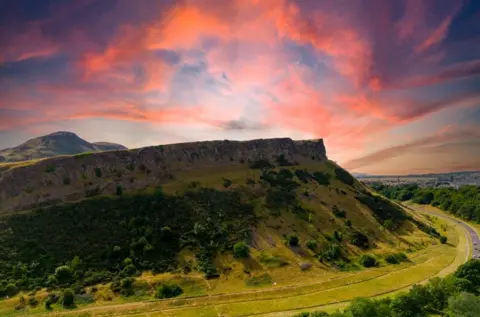It offers one of the iconic views of Edinburgh that has been celebrated in books and paintings for centuries.
But access to the city’s Radical Road path – set high along cliffs at Arthur’s Seat, the extinct volcano that is one of Edinburgh’s best-known landmarks – has been blocked since 2018.
This was when 50 tonnes of rock fell from the cliffs, known as the Salisbury Crags, on to the path.
The Radical Road was fenced off and years of rancour and indecision about reopening it have followed.
Stretching for less than a mile in length, the Radical Road packs a lot in when it comes to rich history and stunning views of Scotland’s capital.
It overlooks the Scottish Parliament and the Palace of Holyroodhouse, where senior royals stay when they visit Edinburgh.
The path got its name from the unemployed west of Scotland weavers who were set to work paving a track around Salisbury Crags – a plan suggested by author Sir Walter Scott in the aftermath of the Radical War of 1820.
It also contains the location where the founder of modern geology James Hutton arrived at his theory of how and when the world was formed.
Why is the Radical Road closed?
 HES
HESRockfalls on a narrow rocky path that clings to the side of a giant slab of dolerite rock are, unsurprisingly, not a new issue.
The Radical Road has been regularly temporarily closed after significant volumes of rockfall over the last century, including a 100-tonne fall in 2011.
The path was temporarily shut on five occasions in the two years before the 50-tonne fall in late 2018 sparked the current closure.
At the time, park operator Historic Environment Scotland (HES) did not have an established policy on categorising what levels of rockfall risk would be considered acceptable.
This was produced six years later and shows that three section of the Radical Road – the ones where it is at its narrowest below Salisbury Crags – currently present an unacceptable risk to the public.

The section with the highest and intolerable risk has an estimated probability of a fatality from a rockfall event of one in 4,886.
This compares with one in 95,435 for the section with a tolerable risk, where the rockface is set much further back from the path.
Fairhurst, an engineering firm used by HES, also argues that its work elsewhere in the park has led it to conclude the “number of actual rockfalls is higher than the number that is identified and reported in all areas “.
What has been the impact of the closure?
HES bills Holyrood Park as the “most important open public space in the city” so closing one of its most popular paths has had a big impact.
The Radical Road itself has become overgrown without usage for years but HES says the wider path network is now “highly degraded” from the pressure of user numbers outweighing the capacity of the paths.
Closures due to rockfalls elsewhere in the park, as well as wildfires, have not helped.
HES does not have an up-to-date handle on how many people are using the park but an estimate from 2016 suggests more than two million visits a year.
The 14 rangers who help manage the park are busier than ever.
They dealt with 314 incidents, such as missing persons or fires, in 2023 – up from 162 incidents in 2018.
What needs to happen to reopen the Radical Road?
Engineering firm Fairhurst first presented HES with options for long-term rockfall mitigation in 2019.
It was asked to revise them in February last year to reflect the new rankings of what levels of rockfall risk would be considered acceptable.
This report shows that to reopen the Radical Road the majority of the 0.8 miles (1.3km) route will need some form of engineered rockfall fence and netting.
This would be similar to the measures in place on the rockface below Edinburgh Castle.
 Getty Images
Getty ImagesOther wider sections of the Radical Road would have a sloped earth embankment built to catch any rockfall.
Fairhurst suggest this earth bund would need a fence on top to stop people getting in to the rock trap area.
The firm’s 2024 report estimates all of these remediation measures could cost up to £2.4m.
A partial reopening
Ranger-led guided walks in some sections of the Radical Road are available but a bigger step in the right direction for campaigners will come next year with a planned partial reopening.
Under the plan, the path between an area called The Hawse to the northern end of South Quarry would be open again.
This will allow full access to the areas where James Hutton pioneered his theory that the Earth’s age could be calculated using observations of volcanic rock.
Edinburgh-based geologist Angus Miller, said: “It’s great that we are going to get access to the most geologically important features of the Radical Road but it has taken far too long.
“I don’t think there has been an appreciation of what the route means to people and the impact of its closure on the wider park.”
Ramblers Scotland director Brendan Paddy said: “After years of dithering, delay and broken promises, HES bosses must now stop kicking the can down the road.
“They must publish clear plans showing how they will reopen the 200-year-old Radical Road and boost the wider Holyrood Park path network – then urgently crack on with delivering trails worthy of this world-famous heritage site.”
 Getty
GettyMaking any changes in Holyrood Park is complicated as it is regulated by its own law and protected by three further pieces of conservation legislation.
Operator HES says wildfires and rockfalls elsewhere in the park over the last year meant its “limited resources” had to be temporarily diverted from the Radical Road but progress was still being made.
A spokeswoman said: “Work has taken place throughout 2025 as part of our commitment to reopen part of the Radical Road next year.
“This includes inspection and descaling works, vital rock trajectory modelling and analysis, and necessary ecological surveys.”









